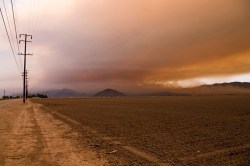
wanderingnomeSmoke from the Springs Fire blows over a dry Californian landscape.
An inferno that led to the evacuation of thousands of Southern Californians last week was a harbinger of a nasty fire season ahead for America’s West and Southwest.
A change in the weather on Sunday helped firefighters start to bring the Springs Fire in the Santa Monica Mountains under control, three days after it sparked to life amid hot and dry conditions.
Much of California is particularly dry and unseasonably brown this year. Storms stayed away from the state over the winter and mountains are covered with just a thin layer of snow.
[Ventura County Fire Capt. Dan Horton said] that a blaze like this one typically doesn’t strike until deep into summer or fall, after the summer’s dry heat has withered hillside vegetation.
“The hot, dry conditions we have seen are usually what we see in July,” Horton said. “It does raise our level of concern. If this is any indication, we are definitely looking at a difficult fire season ahead.”
The blaze is one of more than 680 wildfires in the state this year — about 200 more than average. The state has seen a severe drought during the past year, and the water content of California’s snowpack is only 17% of normal.
This ongoing firefighting effort coincided with publication of a new study by the National Oceanic and Atmospheric Administration that warns climate change may increase drought conditions in some places even as it brings heavier rainfall to others. The L.A. Times makes the link:
The study arrives as a large wildfire has burned thousands of acres in Ventura County. Although many factors have shaped the spread and severity of the fire, the land may have been primed by low rainfall in California.
Climate change does not cause forest fires but does contribute to their likelihood, [Pacific Institute President Peter] Gleick said, adding: “It’s not about causality but influence.”
The Springs Fire began raging a day after the National Interagency Fire Center warned of high fire risks this spring and summer in West Coast states, the Southwest, and parts of Montana and Idaho.


